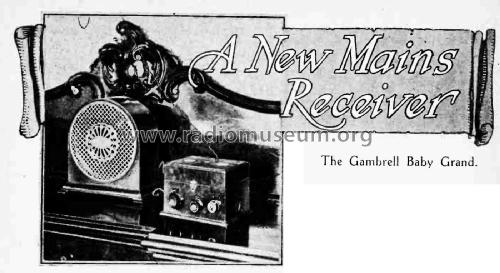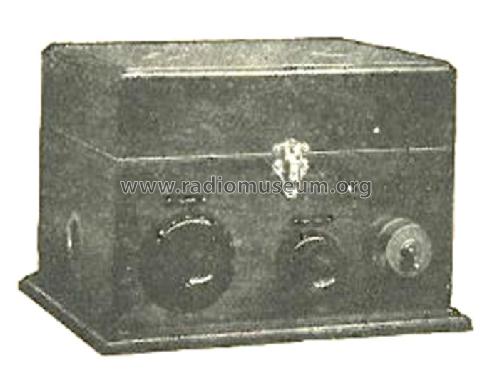Baby Grand (DC (Mains Model) Table
Gambrell Bros.Ltd., London
- País
- Gran Bretaña (GB)
- Fabricante / Marca
- Gambrell Bros.Ltd., London
- Año
- 1926
- Categoría
- Radio - o Sintonizador pasado WW2
- Radiomuseum.org ID
- 254753
- Numero de valvulas
- 2
- Principio principal
- RFS con reacción (regenerativo)
- Número de circuitos sintonía
- 1 Circuíto(s) AM
- Gama de ondas
- OM y OL
- Tensión de funcionamiento
- Red: Corriente continua (CC, inglés = DC)
- Altavoz
- - Este modelo usa altavoz exterior (1 o más).
- Material
- Madera
- de Radiomuseum.org
- Modelo: Baby Grand [Table] - Gambrell Bros.Ltd., London
- Forma
- Sobremesa, caja, normalmente con tapa (panel no inclinado).
- Ancho, altura, profundidad
- 13 x 15 x 9 inch / 330 x 381 x 229 mm
- Anotaciones
-
Grambrell Baby Grand, DC Mains, Table Model
Draws all current, high tension, low tension, and grid bias from the DC mains.
Simply plug it into to ordinary lamp socket.
A wonderful 2-valve set for loudspeaker reception of local and high-power stations, complete with 2 BTH, coils for BBC high power & local stations, Length of flex & adaptor.
Priced at £15.15.0.
First British-produced Receiver with self-contained mains power supply.
Available as AC or DC mains and in table and cabinet models.
- Precio durante el primer año
- 15.75 GB £
- Mencionado en
- Benjamin catalog
- Documentación / Esquemas (1)
- Wireless World (The), London (WW, 79) (Dec 1, 1926, Page 29)
- Autor
- Modelo creado por Konrad Birkner † 12.08.2014. Ver en "Modificar Ficha" los participantes posteriores.
- Otros modelos
-
Donde encontrará 42 modelos, 36 con imágenes y 6 con esquemas.
Ir al listado general de Gambrell Bros.Ltd., London
Contribuciones en el Foro acerca de este modelo: Gambrell Bros.Ltd.,: Baby Grand
Hilos: 1 | Mensajes: 1
Extract from Wireless World April 21, 1926, Page 593 & 594.
Progress in Mains Receiver Design.
During the last couple of years, a good deal of progress has been made in the direction of eliminating batteries where electric supply is available, & many experimenters have had such a system in use for a long while past. It is comparatively recently, however, that sets have appeared on the market embodying the necessary equipment to provide LT & HT current from the mains.
An interesting little set operating from direct current mains has been produced by Messrs, Gambrell Bros. Ltd. and is called the Baby Grand. This is a two-valve set, consisting of a detector valve with reaction & one stage of low-frequency amplification. By interchange of coils, longwave stations can be received as well as the ordinary broadcast band at suitable ranges.
The valves used are 60 mA types, viz, the BTH, B5 & B7, the latter being used, of course for the low-frequency stage. The illustration serves to show the compactness of the set & the arrangement of the components. Photographed in use with an Amploin Radiolux one obtains a good idea of the comparative size.
The Mains Unit
 The photograph taken of the instrument with the lid open shows the resistance unit for dropping the potential of the mains to the required values. Terminals are shown on the left of the resistance unit in the lid, so that connection can be made to suit the voltage of the mains with which the receiver is to be used.
The photograph taken of the instrument with the lid open shows the resistance unit for dropping the potential of the mains to the required values. Terminals are shown on the left of the resistance unit in the lid, so that connection can be made to suit the voltage of the mains with which the receiver is to be used.
The smoothing unit, consisting of condensers & a choke, is incorporated in the box behind the valves & as a precaution, a fixed condenser is inserted in both the aerial & earth leads.
The mains connection is made into an ordinary lamp holder, & aerial, earth & loudspeaker connections are made to terminals at the back of the set in the usual way. The valve filament circuits are arranged so that no adjustable filament resistance is required, the correct resistance value is chosen, & the two valves operate in series, thus effecting an economy in current consumption, the required drop in mains voltage being less.
Results of Test
Using this set some little distance from London, ample volume was obtained both from 2IO & Daventry with a standard aeria. London could also be received with a small indoor aerial with adequate loudspeaker volume up to distances of 3 to 5 miles, but this does not indicate a limited range.
For those with a direct lighting supply who want a simple broadcast receiver without the trouble of batteries, the set can be thoroughly recommended.
There is, whilst the set is in operation, a trace of commutator ripple still present, which varies in intensity, depending on the conditions at the power supply station; but when the transmission is actually in progress this hum is not noticeable. The presence of a very slight trace of hum when no broadcasting is on is, perhaps, an advantage rather than an objection because it indicates the set is switched on, & because of the simplicity of the arrangement it might be very easy to leave the set running in the absence of some such indication that the valves were in use.
We think, however, that there is still room for some improvement in the smoothing unit, & no doubt the designers will take this into consideration in future editions.
Gary Cowans, 16.Jun.23


